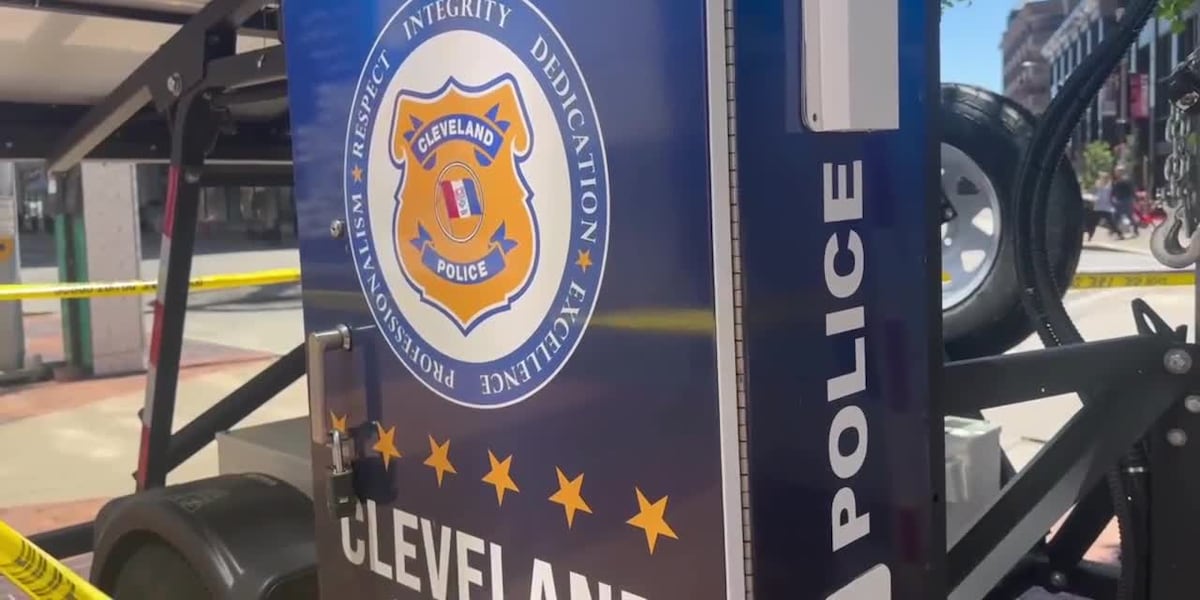Cleveland, OH
Downtown Cleveland Sees the Most Bird-Building Collisions In Ohio. This Group Wants to Eliminate Them

Mark Oprea
Michelle Manzo, of Lights Out, holds a small black-throated green warbler that hit the side of the Rocket Mortgage FieldHouse. Manzo is a regular bird patroller for the organization.
Recently, at 4:30 in the morning, Michelle Manzo woke up in her west side apartment and drove downtown sporting a neon reflective safety vest and lugging a sea-foam green net a child might use to catch butterflies. As soon as she arrived in front of the Rocket Mortgage FieldHouse to meet friends Kent Starrett and Brenda Baber, she was crestfallen.
“They turned all the lights on, for whatever reason,” Manzo recalled, walking through an alleyway near East 9th and Rockwell hours later, as Starett and Baber trailed her. She had heard the melodic call of an ovenbird close by, and feared that the FieldHouse’s glow would lead to a collision.
Manzo related the ovenbird’s voice. “How would you describe it?” she said. “Teach-er! Teach-er! Teach-er!“
Manzo, along with Starrett and Baber, are the central force of Lights Out Cleveland, a nonprofit group of volunteer patrollers formed to curb, and one day eliminate, bird-building collisions. It’s a particularly bad phenomenon here in Cleveland. Three-thousand birds a year, on average, have been scooped—dead or still alive—up by Lights Out patrollers since the organization formed in 2017.

Mark Oprea
Brenda Baber, Michelle Manzo and Kent Starrett, all volunteer birders for Lights Out, stand in front of the Hilton building downtown in early June.
Tim Jasinki, a wildlife rehabilitation specialist and lifelong birder who helped birth Lights Out, told Scene that, due to its unique position in the southward stream that is the songbird migratory path, Downtown Cleveland is about one-and-a-half to two times as lethal for avian species than any other city in Ohio.
“It’s not good,” he said. “You can do the math on that. That’s a lot of birds.”
Running primarily on donations through the Lake Erie Nature & Science Center in Bay Village and volunteer birders, Lights Out is facing a sort of understaffing setback. And at the worst time. While they’ve collected, saved, or healed 697 birds since migration began in January, Jasinki estimated that the fall return trip—birds with their offspring—could ramp that number up to 2,500.
It’s quite a daunting number for volunteers like Manzo, especially when ranks remain thin. On any given day, no more than three to five patrollers show up, to circle glass-heavy buildings and bag bird carcasses for three hours as a time. (Jasinki said Lights Out needs “about a dozen” volunteers to sufficiently wrangle the five downtown routes.) A gig that isn’t appealing for everyone.
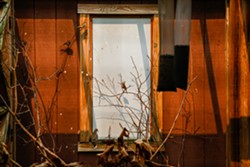
Mark Oprea
A small enclosure at the Lake Erie Nature & Science Center was converted into a sort of halfway facility for healing birds, who, after close observation, will be set free.
“I mean, it’s a lot of walking, it’s early mornings, and it’s a lot of death. It sucks,” Jasinki said. But the alternative isn’t feasible. Without Lights Out patrolling, birds “will be swept up and thrown in the trash if we wouldn’t collect them,” he said, “or eaten by gulls or rats, or whatever.”
A self-taught birder and wildlife specialist, Jasinki grew up in Northeast Ohio enthralled by collecting practice. When he was seven, he started carrying home maimed cardinals and pigeons, to place in little cages in his bedroom.
“I’m just really good at catching stuff,” Jasinki said, walking around the Nature Center rehab center in khaki shorts and Merills. Jasinki checked on the various kennels and enclosures where, on average, 30 birds per day with drooping wings or ossifying skulls heal. Five interns worked around him, entering data or measuring earthworms for baby robins.
Jasinki gripped a grey catbird, from a marked paper bag, to administer a drop of meloxicam, a pain reliever.
“It’s just a little drip on their bill,” he said. The catbird froze in Jasinki’s palm. “He has a shoulder fracture. Probably could be a cat attack, could be a window collision.”
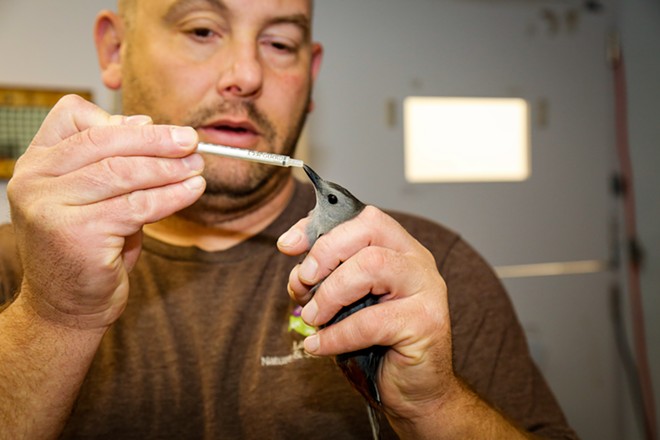
Mark Oprea
Tim Jasinki, a wildlife rehab specialist at the Lake Erie Nature & Science Center in Bay Village, administers a grey catbird a dose of meloxicam, an anti-inflammatory pain medication. It’s like the catbird will be released three to five days after.
After working for Pet Supplies Plus for 15 years, in 2010 Jasinki scored a seasonal internship working in the Nature Center’s basement rehab clinic, where up to 115 of species—including, this season, 157 American Woodcocks, 137 Common Yellowthroats and four hairy woodpeckers—have been rehabilitated at a time. His pure enthusiasm, veering on obsession, is what convinced Metroparks higher-ups he could manage the work. He never left.
In early 2017, after 18 injured woodcocks were brought in, Jasinski knew he needed a birding patrol group, the kind that existed already in downtown Columbus and Chicago. He petitioned Harvey Webster, the chief wildlife officer at the Museum of Natural History, and Matthew Shumar, a coordinator of the Ohio Bird Conservation Initiative, to formulate Lights Out’s collaboration team. The cause is simple from the environmentalist’s perspective: the early-morning light and reflective glass of Downtown’s buildings messes with birds’ deep migratory instincts.
“They’ll collect there to feed,” Manzo told Scene on a recent patrolling outing, pointing to a range of sumac trees near the Federal Building. “And then they are flying around, and they think they can go straight, and—bam!—there’s a glass plate.”
“They see the reflection,” Starrett, a retired IT technician in his early seventies, said nearby. “They think that’s just more trees.”

Mark Oprea
The Rocket Mortgage FieldHouse glass facade is particularly lethal for migrating birds, due to its high reflection and its propinquity to tree lines. The FieldHouse, Jasinki said, are well aware, and are taking steps to manage its lighting. “They’re very helpful,” he said.
Though not all volunteers admit it, they’re one-half planning advocates leaning on political interest. Like in Chicago, one of the first Bird Friendly cities in the country, patroller-activists are at constant battle with developers and building owners, either attempting to sell the benefits of non-reflective glass or urging the latter to install light-dissipating glass, like the popular Feather Friendly window markers.
According to Jasinki, after Cleveland State University installed such on its College of Law building, the patrol stop—one of Starrett’s busiest routes—became obsolete.
“They put Feather Friendly on it, and haven’t had a collision since,” he said.
As far as problematic buildings that are frequent stops, the Federal Building and AECOM building on East 9th come to mind. Public Square is dangerous due to its quantity of vegetation. The Huntington Building, once a high target for bird collisions, was convinced by Lights Out to extinguish its nighttime lighting. Rocket Mortgage FieldHouse officials, Jasinki said, are “trying lighting options now.”
“They’re very helpful,” he added. “Good people. They understand.”
That’s the ultimate legislative goal, to make Lights Out essentially non-needed: to, one day, see legislation introduced in County Council to force all new construction to carry Feather Friendly glass, in some capacity. Sunny Simon, the chair of Cuyahoga County Council’s Education, Environment & Sustainability Committee, is rumored to be working on such.
On the recent patrol, a little past 8 a.m., the sunrise brightening the noisy trees on Prospect Ave., Manzo and her team talk bird law, the city’s awareness of what they do, about “what we’d do if we had 20 of us.” (Expand.) If anything, Lights Out has only made friends in their eight-mile treks. Construction workers tease them. Security guards know them on a first-name basis.
“We’ve gotten to know the maintenance people at every building,” Baber said as the group trekked south towards the FieldHouse. “They’ll be like, ‘Hey! I saved this bird! I put it over in the flower box for ya!’” Baber smiled. “Yeah, they’ll actually do that for you.”
As the team regrouped, pausing for a break, a tiny thud is heard some 15 yards up the block. Per the group’s instinct, their heads turn to examine.
“We got a bird here! I think we got a bird!” Starrett shouted, already in a sprint.
“Ohhhh,” Manzo said, in tones of mourning.
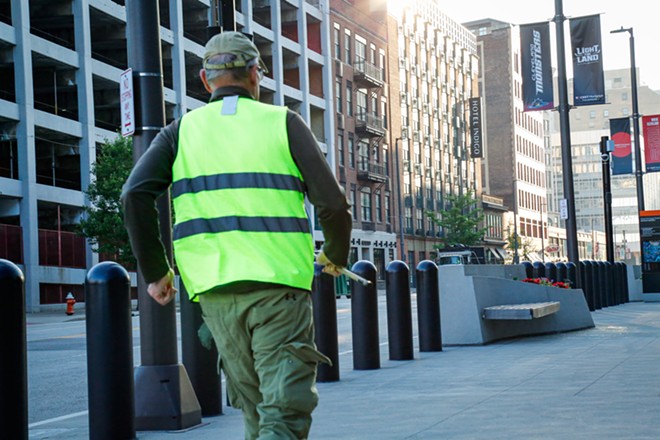
Mark Oprea
Starrett runs over to rescue a warbler.
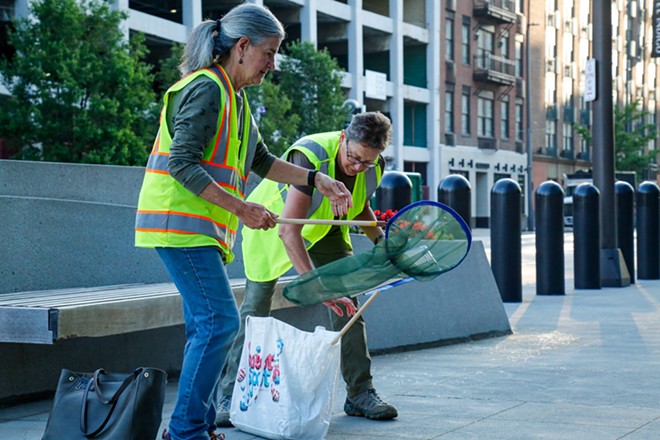
Mark Oprea
Manzo and Baber prepare the net and bag.
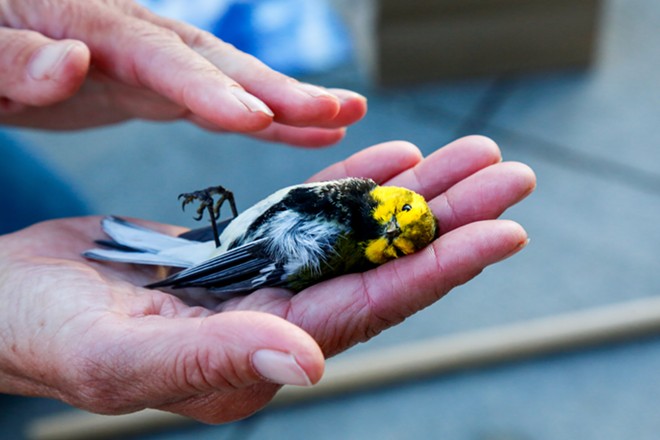
Mark Oprea
A black-throated green warbler.
Manzo and Baber circle a small black-throated green warbler, a songbird with black wings and a yellow throat. Manzo kneeled, and gently covered the warbler with her net, before softly stroking its feathers. Baber prepared the paper bag. For a brief moment, a hush fell over the group as the warbler went still upside on Manzo’s palm. “Oh,” Baber said, “I don’t think he’ll make it.”
The warbler was placed in the bag, later to be frozen and sent to Hiram College ornithologists. (Another backlog at the moment.) Manzo stood up. She tilted her head, as if to preempt another collision.
“Sometimes it can be heartbreaking at this building,” she said. “You can be picking up a bird, and another one’s going to fall right next to you.”
Minutes later, exactly that happened. The group rushed over. “Go! Go! Get away from there!” Starrett screamed to the seagull that swooped in.
“Oh,” Starrett said, approaching the bird body. “It’s just a house sparrow.”
“Yep,” Manzo said, walking away. “We don’t take them. They’re pests.”
Subscribe to Cleveland Scene newsletters.
Follow us: Google News | NewsBreak | Reddit | Instagram | Facebook | Twitter

Cleveland, OH
Cleveland area FirstEnergy customers can weigh in on proposed rate hike at PUCO hearing

CLEVELAND — FirstEnergy is asking the Public Utilities Commission of Ohio for a $190 million increase in what it charges customers for electric distribution.
That’s not for the energy you use but rather costs related to sending service to your home through their power lines.
Based on typical customer usage, it would mean a $13 a month increase for Cleveland area Illuminating Company customers or just over $150 a year. The rate hike for Ohio Edison customers would be less at $2.99 a month and Toledo Edison at $1.56.
As part of their review process, the PUCO is holding hearings on the rate hike request, where at least one of the five PUCO commissioners will be in attendance.
“So its consumers’ chance to be face to face with a PUCO commissioner, letting him or her know how the case would impact them,” said JP Blackwood of the Ohio Consumers’ Counsel, the state agency whose job it is to watch out for and represent Ohio consumers.
At a local public hearing, consumers can share their views face-to-face with at least one of the five PUCO commissioners who will decide on the case. Those who testify will have their comments included as evidence that the PUCO must consider in ruling on the utility’s request.
The three meetings slated are;
- Cleveland: 5 p.m., Thursday, April 3, 2025, Cleveland Public Library, Learning Commons Space, 325 Superior Ave., Cleveland, OH 44114,
- Akron: 6 p.m., Monday, April 7, 2025, Akron-Summit County Public Library, 60 S. High St., Akron, OH 44326.
- Toledo: 6 p.m., Monday, April 14, 2025, Board of Lucas County Commissioners, One Government Center, Suite 800, Toledo, OH 43604.
As part of their review process, the PUCO’s staff conducted their audit of the rate hike request, and they concluded that instead of a $190 million hike, a more modest $8.5 million jump was more appropriate. But the Ohio Consumers’ Counsel review of the application found that the PUCO should force FirstEnergy to cut its rates.
“Using the numbers from FirstEnergy’s application, just the information about how they’re providing the electricity they deliver and how they’re working,” said Blackwood. “We are proposing actually an $18 million decrease for Cleveland Illuminating Company rates and overall more than $100 million decrease for the entire rate case.”
In a statement Ma,ureen Willis, Agency Director of the Office of Consumers’ Counsel, said further, “instead of a $190 million distribution rate increase, the FirstEnergy utilities should be getting a haircut. Consumers’ electric utility bills are already packed with soaring transmission costs and rising energy prices. Affordability remains a key issue for Ohio families and businesses.”
Cleveland, OH
Cuyahoga County officials preparing for severe weather

CLEVELAND, Ohio — Severe weather is on the way, and local officials are getting prepared.
Bryan Kloss, Emergency Operation Center manager for the Cuyahoga County Office of Emergency Management, said severe weather is one of their focus areas.
“So we’re always looking at, what’s the risk? What’s the threat? What are the hazards?” he said.
For this weather event, he said they’re expecting flooding and rain, so that’s what they’re focused on.
“So our process is we’ll obtain the information from the National Weather Service,” he said. “We’ll identify how high our risk is. This weather’s pretty standard for our time in April/May months for this type of weather.”
They coordinate with local emergency services such as fire and police to let them know about the weather ahead of time, offering them tips, tricks and best practices.
On the public side, he said they try to remind people about what to watch. If there’s water on the road, turn around. Don’t attempt to drive through it. Always be cautious of moving water and keep a preparedness kit.
Kloss said people should keep a kit both in their home and in their vehicle. Car kits should include road flares, jumper cables, emergency blankets, water and food, Koss said, along with a communications method.
Kits at home should include enough food, water and medication in case of a power outage. Kloss also said homes below the water line should make sure their sump pumps are working properly and they have a battery backup.
“The other big tip, and it’s not necessarily a failure point on the public, but to just stay informed,” he said. “We always want the public to stay informed and have weather alerts set up on their phone with whatever platform they prefer.”
According to the Ohio EMA, there is the potential for heavy rain, strong wind, hail and even tornadoes.
“These hazards have consequences including flooding, property damage, power outages, injury and even death,” Sandy Mackey with the Ohio EPA said in an email. “Being aware of the hazards that may impact your location is important and can help you prepare and stay safe.”
They said they advise Ohioans to never drive through flooded roads and always look for an alternative route, adding it’s important to know where to go to seek shelter prior to storms. They added it’s important to have multiple ways to receive emergency notifications, whether it’s via radio, text or county-wide mass notification systems.
Cleveland, OH
‘Slap in the face’ to Cleveland: Congresswoman Brown confirms Celebrezze Federal Building to be sold
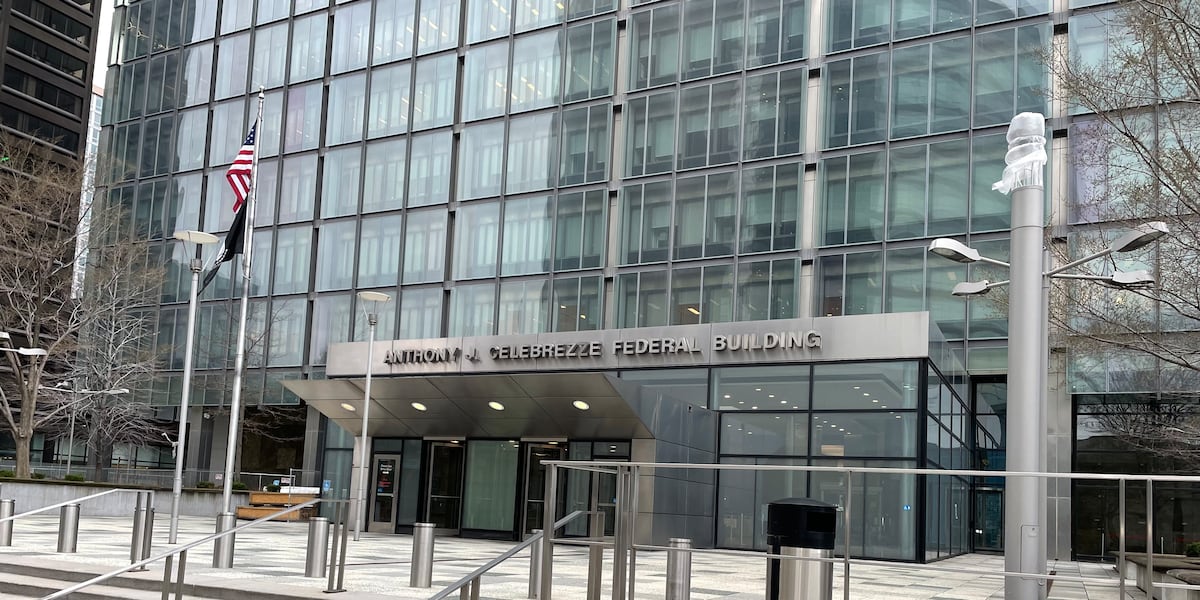
CLEVELAND, Ohio (WOIO) – Congresswoman Shontel Brown (OH-11) has confirmed the U.S. General Services Administration’s (GSA) plan to sell the Anthony J. Celebrezze Federal Building in Downtown Cleveland, calling the decision a “slap in the face” to Cleveland.
Rumors over the potential closure and sale of the AJC building have been swirling since its appearance on a GSA disposal list earlier this month. The building had been listed for sale, then removed days later with no explanation given by the GSA.
The building was on the “non-core property list”, which identifies buildings that the U.S. General Services Administration deems are not “core to government operations, or non-core properties”.
“The Trump Administration is delivering a slap in the face to the City of Cleveland by rushing to sell the Celebrezze building,” said Congresswoman Brown. “The Celebrezze building is a critical cornerstone for Cleveland’s federal operations and a vital anchor for the downtown economy. This reckless and short-sighted fire-sale will disrupt essential federal services and undermine the City’s critical investments in the downtown economy. What’s more, it will inflict further trauma on public servants, who have been relentlessly attacked by DOGE and this Administration with return-to-work orders and indiscriminate firings. Our city and our people deserve better than being treated as collateral damage in DOGE’s reckless cost-cutting schemes.”
Congresswoman Brown says the federal government will look to short term leases for the 4,000+ employees that use the building within multiple federal departments. She fears that it would leave to even greater uncertainty:
“There is no guarantee that suitable relocation options will even be secured. The likely outcome is therefore not merely disruption—it is a direct reduction in federal employment in Ohio, with serious consequences for the local economy.”
The AJC building would be sold within the next three years, with the Congresswoman’s office telling 19 News that the federal government would need to find leases for every agency in the building, ensuring there is enough space, and physically move all equipment.
Agencies in the building include: Veterans Benefits Administration (VBA), Defense Finance and Accounting Service (DFAS), the Department of Homeland Security (DHS), the Internal Revenue Service (IRS), and the Equal Employment Opportunity Commission (EEOC).
19 News has reached out to the GSA for comment and have yet to hear back.
Last week, Cleveland Mayor Justin Bibb and Cuyahoga County Executive Chris Ronayne called on the federal government to keep the building under federal ownership to keep these agencies downtown.
Copyright 2025 WOIO. All rights reserved.
-

 News1 week ago
News1 week agoTrump Is Trying to Gain More Power Over Elections. Is His Effort Legal?
-

 News1 week ago
News1 week agoWashington Bends to RFK Jr.’s ‘MAHA’ Agenda on Measles, Baby Formula and French Fries
-

 World1 week ago
World1 week agoAt least six people killed in Israeli attacks on southern Syria
-

 News1 week ago
News1 week agoCompanies Pull Back From Pride Events as Trump Targets D.E.I.
-

 Technology1 week ago
Technology1 week agoTrump officials planned a military strike over Signal – with a magazine editor on the line
-

 Technology1 week ago
Technology1 week agoThe FBI launched a task force to investigate Tesla attacks
-

 World1 week ago
World1 week agoNo, Norway and Sweden haven't banned digital transactions
-

 Culture1 week ago
Culture1 week agoAnalysing Jamal Musiala’s bizarre corner goal for Germany against Italy


